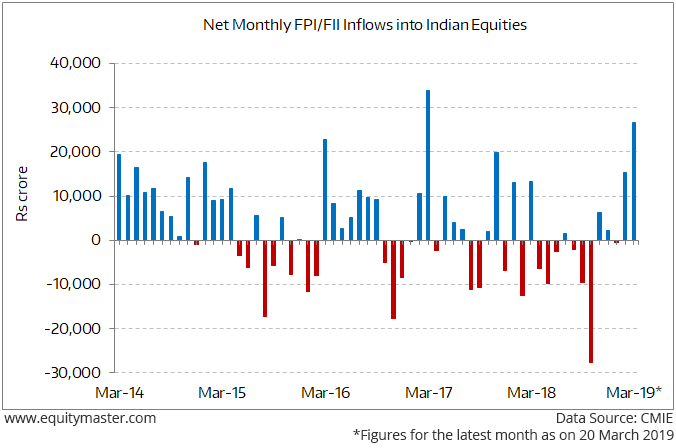Investment in securities market are subject to market risks. Read all the related documents carefully before investing
Savings of RS 6,050 on Our
Small Cap Research?
- Home
- Todays Market
- Indian Stock Market News March 28, 2019
Sensex Opens Flat; Realty and IT Stocks Gain Thu, 28 Mar 09:30 am
Asian stock markets are lower today as Japanese and Hong Kong shares fall. The Nikkei 225 is off 1.5% while the Hang Seng is down 0.1%. The Shanghai Composite is trading down by 0.3%. US stocks eased on Wednesday as Treasury bond yields fell again and a prolonged inversion in the yield curve fanned fears of a US economic slowdown.
Back home, India share markets opened on a flat note. The BSE Sensex is trading up by 21 points while the NSE Nifty is trading up by 11 points. The BSE Mid Cap index and BSE Small Cap index opened up by 0.4% and 0.2% respectively.
Barring bank stocks and telecom stocks, all the sectoral indices have opened the day in green with realty stocks and information technology stocks leading the pack of gainers.
The rupee is currently trading at 69.02 against the US$.
The rupee weakened marginally by 2 paise to close at 68.88 against the US dollar on Wednesday amid strengthening of the American currency and robust selling in domestic equities.
Reportedly, increased demand for the US currency from importers weighed on the rupee. However, sustained foreign fund inflows and easing crude oil prices cushioned the fall.
At the Interbank Foreign Exchange (Forex) market, the domestic currency opened lower at 68.98 a dollar but soon pared some losses. It finally settled at 68.88 per dollar, down 2 paise over its previous close.
On Tuesday, the rupee had appreciated by 10 paise to 68.86 following a robust response to RBI's maiden rupee-dollar swap auction.
Under the rupee-dollar swap auction conducted Tuesday, the Reserve Bank received bids for US$16.31 billion, against the notified amount of US$5 billion.
Foreign institutional investors (FIIs) remained net buyers in the capital markets, putting in Rs 14.8 billion on Wednesday.
Foreign investors are back in the news.
The recent surge in the Indian stock markets can be also attributed to the strong foreign investor inflows into Indian equities.
The chart reveals the monthly trend in foreign investor flows into Indian equities over the last five years. The period almost coincides with the term of the Modi government.
Are Foreign Investors Coming Back to Indian Equities?
During this period, you can see that foreign investor participation in Indian equities shrank.
Over the last five years, foreign investors were net sellers in 24 months. Effectively, foreign investors were net sellers 40% of the time.
The chart shows that the highest monthly net foreign investor inflow over the last five years was recorded in March 2017 at Rs 337.8 billion.
However, foreign investor flows are influenced by a myriad of global factors and are susceptible to change course anytime.
Moving on to the news from oil & gas sector. As per an article in a leading financial daily, Indian Oil, Hindustan Petroleum, Bharat Petroleum, and GAIL have exceeded their capital expenditure targets for the current fiscal, having spent heavily on refinery upgrades, pipelines, and marketing infrastructure.
The combined capex target set for all state-run oil producers, refiners and marketers for FY19 is Rs 893.4 billion, of which they have collectively spent Rs 827.1 billion, or about 93%, in the 11 months through February.
Oil and Natural Gas Corp, which typically has much higher spending budget every year than the refiners, has spent about 80% of its annual target of Rs 320 billion. Its overseas arm, ONGC Videsh, has used up about 85% of its Rs 58.9 billion target, while Oil India has spent 78% of its target of Rs 43 billion.
GAIL and refiners Indian Oil, HPCL and BPCL have surpassed their annual target in 11 months. BPCL has spent Rs 89.9 billion, or 121% of its target.
GAIL, which is investing heavily in laying a gas pipeline in eastern India, had spent Rs 50.6 billion until February, or 107% of its target for the year.
HPCL has already used up 106% of its annual outlay. Indian Oil has invested 103% of its target.
Refiners have been upgrading their facilities to produce lower-emission fuels that will help curb intense air pollution in cities. They have also been spending on setting up new pipelines, depots and retail outlets, the reports noted.
Indian oil companies have been investing heavily in finding, refining and distributing oil and gas across the country for the last many years to meet mounting demand for fuel and feedstock.
Meanwhile, economic expansion has pushed up oil demand by 3.2% during April-Feb of 2018-19. India is also hoping to increase its domestic oil output and reduce its dependence on import by making massive investments in exploration and production.
Domestic crude oil output has been declining for years. India imports about 80% of the oil and about half of the natural gas it consumes. The import bill of crude oil is estimated to expand 27% from US$88 billion in FY18 to US$112 billion in FY19.
To know what's moving the Indian stock markets today, check out the most recent share market updates here.
For information on how to pick stocks that have the potential to deliver big returns, download our special report now!
Read the latest Market Commentary



Equitymaster requests your view! Post a comment on "Sensex Opens Flat; Realty and IT Stocks Gain". Click here!
Comments are moderated by Equitymaster, in accordance with the Terms of Use, and may not appear
on this article until they have been reviewed and deemed appropriate for posting.
In the meantime, you may want to share this article with your friends!